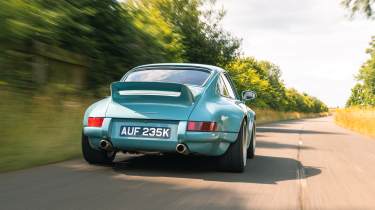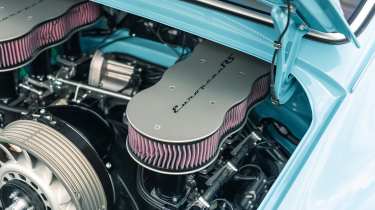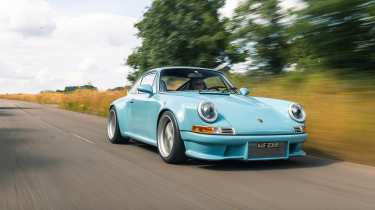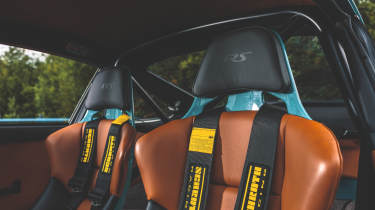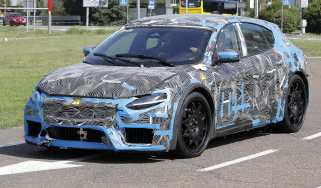Thornley Kelham Porsche 911 European RS restomod review – worth £650k?
The Thornley Kelham Porsche 911 European RS attempts to mix the character of a 997 4.0 RS with the visual brawn of a 2.8 RSR
What did you do during the Covid lockdowns? While most of us were sorting through long-lost boxes of photographs or binge-watching Tiger King, retired architect Hal Walter used the enforced downtime to dream up his perfect Porsche 911. Out of the detailed 36-page document he produced has come this, the European RS, a Porsche 911 restomod unlike any other.
Dividing his time evenly between his homeland of Australia and a second home in the French Alps, when not hiking in the mountains Walter spends his northern-hemisphere summers behind the wheel of his beloved Porsche 911 GT3 RS 4.0. Well attuned to the greatest of all water-cooled RSs, Walter’s dream was to replicate that car’s scintillating performance and intense delivery in an early air-cooled 911 with the lightweight qualities of a 2.7 RS and the muscular look of a 2.8 RSR.
Approaching the process with the same meticulous detail he would an architectural project, Walter obsessed over every area of the car, right down to the gear ratios. Then, instead of handing his plan to a Porsche specialist, he engaged the services of world-class multi-marque restoration company Thornley Kelham. It proved to be an inspired decision.
Before meeting Walter – who arrives in a fabulous Aston Martin DB4 – I’m given a quick tour of the premises by company co-founder Simon Thornley. The facilities are impressive, but it’s the diversity of cars that’s most intriguing. It’s not often you’ll see a perfectly restored Miura sitting in the same space as a spindly early Bugatti, imposing 1930s Rolls-Royce or indeed a freshly hot-rodded early 911.
It’s clear to see why the combination of Thornley Kelham’s expertise and the advantage of fresh eyes on building a 911 appealed to Walter. Fuelled by his passion for the multi-faceted, endlessly fascinating 911 driving experience, it’s obvious how much this project means to him, and how hard he has pushed Thornley Kelham to deliver it without undue compromise, dilution or deviation from ‘The Plan’.
More reviews
Group tests
In-depth reviews
Long term tests
Reviews
The finished car began life as a 1972 911T. With a longer wheelbase than the earliest 911s but still up to 300kg lighter than the later 964-generation models commonly used in 911 restomod projects, it gave Walter a head start when it came to his quest for saving weight.
As it stands, the finished car weighs 1070kg wet. That’s impressive, but Walter reckons he could have shaved a further 30 to 40kg if the roof and fenders had been made from carbonfibre to go with the composite doors, bonnet, deck lid and bumpers. And if he’d opted not to fit air-conditioning, though given he intends to drive the wheels off this car in hot French summers, the compact a/c system is 14kg well used.
And this car really was born for hard driving. The interior is pared right back. Clean, simple and with everything you need but nothing more, its modesty and focus is refreshing. The raised shifter with its exposed linkage mechanism is a brutalist detail but one which typifies the importance Walter places on a driver’s points of contact with the car. The AP pedal box is similarly purposeful and unreconstructed, the firm, direct and silky action of the floor-hinged pedals hinting at the finely hewn driving experience to come.
A pair of remote-damper reservoirs are mounted to the rear bulkhead. There’s a half-cage and full harnesses too. They lend a serious vibe, but the bound-edged carpets, leather upholstered carbon-shelled Recaro seats and understated use of high-quality materials mean the interior ambience is one of curated minimalism, not bare-bones race car.
Your first few miles are spent soaking up the sounds and sensations unique to early 911s. They are smaller and more intimate, which takes some adjustment, but it’s the directness and unfiltered feedback that’s the greatest joy. Initially it’s almost overwhelming. The relationship between throttle opening, acceleration and engine note is synaptic, the dialogue between the road, the front wheels and your hands constant and vividly descriptive. It shines an unflattering light on the heavily filtered drive-by-wire world we now inhabit. In short, it’s magic.
And there’s more. Where an old, pre-impact-bumper 911 would ordinarily have a slightly long-winded gearshift and a somewhat woolly front end, the European RS is urgent and precise. There’s more grip, as you’d expect from a lightweight car riding on generous 18-inch three-piece Fuchs-a-like Fikse FFR rims paired with 225/40 front and 265/35 rear Michelin Pilot Cup 2 tyres, but it’s the combination of newfound front-end bite and the older 911’s appetite for rotation and throttle adjustability that’s truly revelatory.
The front end features the most substantial changes, with a 997 GT3-style Elephant Racing subframe, control arms, mounts, bushes and ball joints. Made from billet alloy it is roughly half the weight of the stock hardware and enables greater adjustment for camber and caster. Alloy rear trailing arms save further weight, while an unassisted Quaife rack (2.5 turns lock-to-lock) speeds up the steering without making it unreasonably heavy.
Like all great 911s, this car places unusual emphasis on your inputs, but once you become dialled in to its behaviour and preferences the European RS is a true livewire: agile, immediate and incredibly throttle adjustable. It dances down the road, cutting clean lines through long, sweeping curves but revelling in tighter turns (or roundabouts…) where you can play with the throttle to get the rearward weight bias and Wavetrac limited-slip differential working for you. It would be absolute bliss on an alpine pass.
It’s super-quick, too. Walter was keen to have what’s described as a 993 Cup-spec engine, which means a 3745cc 12-valve fuel-injected high-compression engine that develops a dyno-tested 385bhp at 7700rpm and 297lb ft of torque at 6000rpm. With individual throttle bodies, billet aluminium heads, hot cams, forged Mahle pistons and a Life Racing ECU it happily revs to 8000rpm with cut-throat throttle response yet runs sweetly at low speeds. Subsequent customer European RSs can be ordered with a variety of engines, including a monster 4.0 24-valve good for in excess of 400bhp with tons of torque, or a smaller 3.6 version that revs to 10,000rpm.
Exhaling through a handmade Inconel and titanium exhaust system, the European RS makes a wonderful noise; one that blends induction snort and classic air-cooled rasp, adding an evil cackle on upshifts and the overrun. Rich and real – no active valves or artificial pops and bangs here – it provides a goosebump-inducing soundtrack that’s perfectly matched to the driving experience. Most impressively there doesn’t appear to be any nasty resonance or boom at cruising speeds. According to Walter it should also pass most circuit noise tests.
The high-set gearlever alters the G50 transmission’s shift feel a little, its extra height and length requiring you to adjust engrained muscle memory to feel your way through the gate. It doesn’t take long, and the new position brings the shifter that bit closer to the wheel for minimal time spent steering one-handed.
The brakes are another highlight; lightweight carbon discs made by Surface Transforms – the same company that supplied the braking system for the Aston Martin Valkyrie. The pedal feel is fantastic, as is the stopping power, and because the discs are light (16.7kg less than a conventional cast-iron set-up) they help with unsprung weight and improve steering response.
Walter is yet to really dig into the suspension set-up, but the JRZ four-way adjustable dampers (matched to Eibach springs) and adjustable, hollow anti-roll bars have near-endless scope for fine-tuning. Subsequent builds will also offer adaptive dampers as an option. As it is, the car feels modern RS firm but still just about pliant enough to be tolerant of cambers and cope with the UK’s crumbling road surfaces.
Perhaps unsurprisingly, the result is an intelligently hardcore classic 911 with a unique character and vastly increased capability. It has a sprinkle of the very early short-wheelbase 911’s magic in the way it comes alive with on-off throttle inputs, but with balance that’s easier to manage. It also has the steering response, point-to-point performance and brilliant braking of a 997 GT3 RS. And then there’s the powertrain, which packs contemporary punch yet brims with the captivating sound and unique mechanical charm of the classic air-cooled engine. Like a perfectly cooked steak, it is rare, but not raw.
Price and rivals
A maximum of 25 European RSs will be built, with prices starting at £575,000, plus the cost of a post-SWB, pre-964 base car. Call it at least £650,000, then. Comparisons with Singer are inevitable, yet excepting the obvious similarities of widebody styling and deep-dish Fuchs wheels, the intensity and focus of Walter’s European RS seems closer to the ethos of a one-off that might gain you an invitation to join the exclusive R Gruppe club. Albeit one finessed with 6000 hours of Thornley Kelham’s concours-winning expertise, not to mention numerous iterations of Walter’s exhaustive masterplan.
The 911 restomodding scene is as crowded as a Tokyo commuter train, but where some efforts muscle in with little respect for those already on board, the European RS squeezes itself in without treading on too many toes. All credit to Hal Walters for committing to his dream, Thornley Kelham for making it real, and to both parties for extending the opportunity to a small group of others with the means to commission their own version of it.
| Engine | Air-cooled flat-six, 3745cc |
|---|---|
| Power | 385bhp @ 7700rpm |
| Torque | 297 lb ft @ 6000rpm |
| Weight | 1070kg (366bhp/ton) |
| Tyres | Michelin Pilot Sport Cup 2 |
| 0-62mph | 3.5sec (est) |
| Top speed | n/a |
| Basic price | £575,000 plus donor |
This story was first featured in evo issue 327


